A sample text widget
Etiam pulvinar consectetur dolor sed malesuada. Ut convallis
euismod dolor nec pretium. Nunc ut tristique massa.
Nam sodales mi vitae dolor ullamcorper et vulputate enim accumsan.
Morbi orci magna, tincidunt vitae molestie nec, molestie at mi. Nulla nulla lorem,
suscipit in posuere in, interdum non magna.
|
I raced the mower around our new asparagus bed, eyeing it carefully. Lacy fern tops spread out above the trenches in the soil that my dad had so carefully dug. I stopped out of sight behind the garage, turned off the engine, and sat watching a dragonfly playing among the feathery branches that dipped and shivered in the Pennsylvania sunshine. It was a perfect moment.
The next spring we got exactly six spears from our asparagus bed. We kids had a little procession as my father carried them up onto the back porch and handed the asparagus lovingly to my mother, who steamed it for dinner. Buttered, my single spear tasted of sweet spring grass tinged with hints of morning dew. And that delicate crunch! I tell you I was hooked right then and there.
Nowadays we Bullhogs can’t get enough; in fact, asparagus is our favorite veggie in the springtime, and the perfect accompaniment to salmon. And while asparagus from California is in the stores already, in a few weeks the first local Yakima asparagus will start appearing, and then the real feeding frenzy begins. As to cooking? I still love those tender stems steamed lightly and dabbed with butter, because it takes me right back to my childhood. But our method of choice these days – especially when the sun shines – is on the grill.
Here’s what to do.
Great Grilled Asparagus 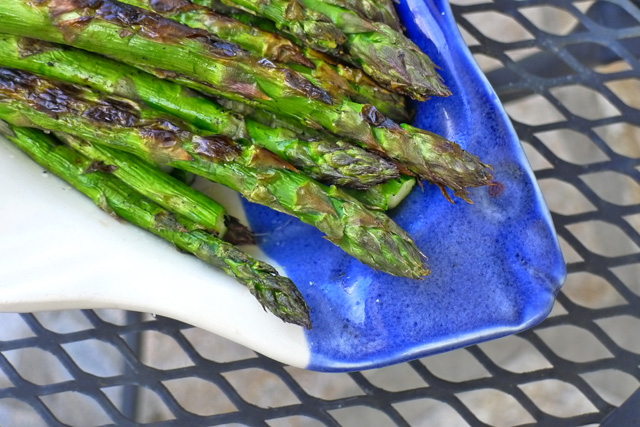
1 pound of fresh asparagus (see note below)
2 teaspoons of olive oil
A pinch of salt
Black pepper, if desired
A note on choosing asparagus: The best asparagus has shiny flesh and a tight bud at the head of each spear. The base should be clean and white where it’s cut. Avoid asparagus spears whose bases are dark, dried out or cracked. For grilling, we find it best to use spears that are as thick as your fingers.
Prepare the grill: Light 25 charcoal briquettes in a small grill (I use a Smoky Joe by Weber) and let them burn for 15 or 20 minutes until most of the black has gone. Spread out the red coals, add about 10 more fresh briquettes and leave the vents open. Clean the grill surface and put it in place.
Prepare the asparagus: Rinse the spears and shake off the excess water. Holding a spear with two hands, find the place about 2 inches from the bottom where the woody base ends and the tender spear begins. Using a small amount of force, bend the spear at this point and the base will snap off. Snap off all the bases, leaving spears that are 6 or 7 inches long.
Drizzle olive oil over the spears and lightly salt them.
Grill the asparagus: Spread the spears crosswise on the grill, with the bases toward the center and the buds out to the edge. Let cook for a minute or two and then turn all of the asparagus over with tongs. (Avoid putting the lid in place unless you like your asparagus limp.) As the asparagus cooks, send the less-cooked spears to the middle of the grill and the more-cooked spears to the edges. Depending on the thickness of your spears, the asparagus will be grilled in 5 to 7 minutes.
Serve this lovely grilled asparagus hot or cold.
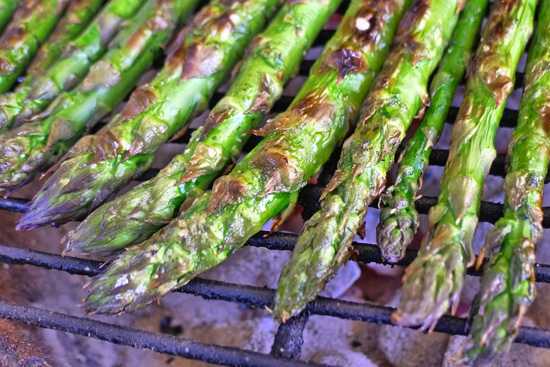
Your Jetta or Beetle might have come from beautiful Puebla, set high on Mexico’s central plain, but we know the city best for its incredible food. Think cemitas, the ultimate street food, or the fabulous Chiles en Nougada if you’re ever there at the right season. With every good restaurant in town competing for the best rendition of Molé Poblano di Sacristia, the place transcends delicious to become a food-lover’s paradise.
 Fabulous street food in Puebla, Mexico The Poblano chile, Puebla’s namesake, is at the heart of this bonanza; fresh, roasted, dried or fried, it is Mexico’s favorite go-to chile. In its most famous dried form – the Ancho – it’s sweet and fruity with mild heat and a rich and pungently fresh flavor. The cool thing is, because Anchos are available everywhere you can enjoy them any time you’re in the mood for a bit of that Mexican zing.
Look for clean, shiny Anchos dried flat to show off their wide heart shape. While the best ones are leathery in texture, they’re not easy to come by. But as an added bonus, Anchos are mild enough to de-stem and seed without putting on gloves. Even so, do be sure to wash your hands well after handling since every once in a while you’ll come across a hot one!
If you’re looking for a real treat, do what we did: take a cooking course at Mesones Sacristia with Chef Juan Hernandez. It’s a great way to see the city through a chef’s eyes and to get your feet wet in this culinary tradition. Meanwhile, here’s a simple and delicious way to taste the flavors of that lovely town.
Ancho Chile Stew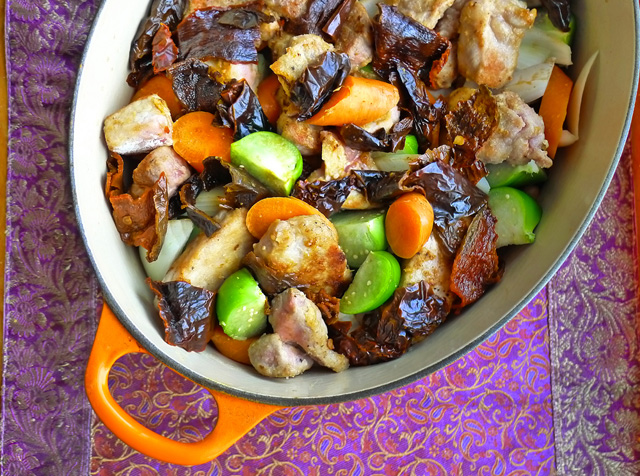
1 cup of dry pinto beans
2 cups cold water
6 Ancho Chiles
3½ cups boiling water, divided
3 pounds of pork chops or shoulder steaks
4 Tablespoons of canola oil
¼ cup of flour
Salt and pepper
1 pound (about 7) tomatillos, quartered
1 large white onion, in 8 pieces
3 large carrots, roughly cut
1½ cups of meat stock
2 teaspoons of dried oregano, preferably Mexican
½ teaspoon of cinnamon
Soak the pinto beans: Put 1 cup of dried pinto beans into a 2 quart saucepan, add 2 cups of cold water and slowly bring the beans to a boil over medium heat. Once the water boils, cover the pan tightly and turn off the burner. Let the beans sit for 20 minutes. Before adding bones, heat the beans to a simmer.
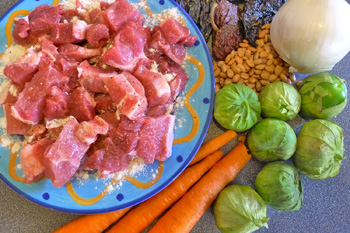 Ingredients for Ancho Chile Stew Prepare the Anchos: Use sharp kitchen scissors to cut along one edge of each chile. Pull the flesh away from the knobby stem and open the chile like a book. Discard the stem, its seedy attachment and as many seeds clinging to its inside wall as you can. Tear the cleaned Anchos into strips about 1” wide and 2” long, put them into a soup bowl and pour on 1½ cups of boiling water. Let the Ancho bits sit for 15 minutes to partially rehydrate them.
Brown the meat: Cut the bones out of the pork. Cut pork meat into pieces about 1” x 2”. Slake the pieces with ¼ cup of flour and generous amount of salt and pepper.
In a large skillet, fry the bones in 2 Tablespoons of canola oil until well browned. Add them to the pinto beans and continue the beans at a simmer. Simmer until the rest of the ingredients are ready – at which time, remove the bones from the beans and broth.
Now brown the pork pieces, about 10 at a time, in the hot skillet, adding a little oil as necessary. Turn meat until medium-brown on at least two sides. Remove cooked pieces to a plate until all meat is browned.
Prepare the veggies: Take the papery skins from the tomatillos. Wash the tomatillos and then cut them in quarters. Peel the white onion, top and tail it, and cut it into 8 pieces. Top and tail the carrots and slice them at an angle into 1” chunks.
Assemble the stew: Put the boneless beans and broth into a 5-quart French oven or heavy casserole. Spread half the meat over the beans, then add half the prepared veggies and half the Ancho strips. Sprinkle with half the oregano and half the cinnamon. Grind on pepper as desired. Now layer on the other meat, veggies, Ancho strips and spices.
Add the juice from the Anchos, the meat stock and up to two cups of boiling water, until the level of the liquid is about 1” below the highest veggies. Cover the casserole and put it into a 350° oven for 1 hour.
Reduce the oven heat to 250° and continue to bake the casserole for 2½ to 3 hours until the meat is tender and the tomatillos have become part of the gravy.
Serve with big hunks of fresh crusty bread for a fabulous treat!
Copyright ©2012 by Don Hogeland
 Some of the many beautiful churches in Puebla, Mexico
I’ve long resisted putting chicken on a pizza. To my taste and sensibilities, chicken doesn’t work well with red sauce; turning to barbecue sauce just muddies the mix. So when I hit on using spinach as a base for this pizza, I realized I was onto a good thing.
This pizza rocks. Ham gives the spinach a zing that balances the chicken’s tender flavor without overwhelming it. The mix of Swiss cheese against the crust and aged mozzarella lightly baked on the surface strikes just the right note. And by making use of a double bake – once to set the crust and heat the spinach base, the other to reheat the precooked chicken – the whole thing comes together perfectly.
So here you go, a fresh take on flavor for a fabulous Spring!
Lean Green Florentine Pizza 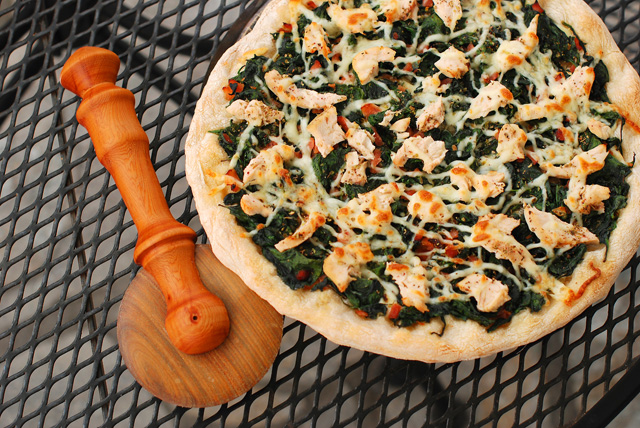
Makes one 12” pizza
1 pound of fresh spinach, washed and drained
2 ounces of ham
2 Tablespoons of olive oil, divided
12 ounces of pizza dough (use your own or click HERE for our favorite)
2 ounces of Swiss cheese, sliced thinly
4 or 5 ounces of cooked chicken breast
Salt and pepper to taste
2 ounces of shredded mozzarella
1 teaspoon of dried oregano
Wilt the spinach: Wash and drain the spinach. Chop the ham into ¼” dice. Set a 12” non-stick frying pan over medium heat and add 1Tablespoon of olive oil. Sauté the ham for 3 minutes and then add the spinach (in 2 lots, if necessary). After a minute, turn the spinach over all the way and sauté the other side for a minute or two. The spinach should be mostly wilted but still bright green. Remove to a bowl. Once cooled somewhat, squeeze the spinach leaves by handfuls to remove most of the liquid. Discard the liquid and separate the leaves.
Prepare the chicken: You can use roasted chicken breast, prepared strips such as those available at Trader Joe’s, or you can fry a boneless breast. If you cook chicken specifically for this pizza, undercook it slightly for best results. Slice the chicken into strips ¼” thick, toss with 1 Tablespoon of olive oil and sprinkle with salt and pepper to taste.
Make the pizza: Spread dough out on a floured counter to make a 12” round. Move to a wooden peel that has cornmeal on it and make sure the pizza blank ‘slips’. Put slices of Swiss cheese on the dough and sprinkle the spinach/ham mixture all over the pizza, leaving a margin at the edge.
1st Bake: Set a pizza stone on the center rack of a conventional oven and preheat it to 475°. If you have a woodfired oven, burn a fire for 2 hours until the ash turns white on the sides of the oven; move the fire to the back and sweep the floor clean. Slip the pizza directly onto the pizza stone or the floor of the WFO and bake it for 3 or 4 minutes until the crust becomes puffy and the spinach is steaming.
2nd Bake: Pull the pizza back out of the oven and quickly top with chicken strips and mozzarella. Sprinkle with oregano and send the pizza back into the oven. Bake for 3 or 4 more minutes until the mozzarella is just beginning to brown. Remove, let cool for a few minutes, and dig in.
Springtime? Bring it on!
Copyright ©2012 by Don Hogeland
 Springtime on a pizza. Spinach and ham mix ready to get to work.
It’s the middle of March, but at our little cabin a mile and a half east of Stevens Pass in the Cascades snow is still falling. When I got here the other day, the trees held a slim margin of snow on their boughs. Overnight their branches became heavy with vast epaulettes of snow. It’s awesome to see and – as the day brightens and the snow continues to fall – it’s even more spectacular to behold.
 Our cabin nestled in 12 feet of snow. (Click to enlarge) We’re enduring what the weather people call a La Niña year. In Seattle that means extra rain. Up here, at the high reaches of the local mountain passes, this means extra snow: some 460 inches to date. All that snow doesn’t just pile up on the ground; it morphs, compacts and compresses, but it certainly has its impact. We’re at 12 feet and counting.
After a short ski in along the unplowed road, I’m suddenly where I love to be. The cabin beckons like a boat in the woods: sturdy, remote and inviting. I hit the power, turn on the water, light a fire and settle in. Outside a winter storm is gathering steam, but inside is the perfect antidote. I am totally happy.
This time, I’ve brought up pork chops, broccoli, beans. I set the little barbecue on the snow and get it hot. I marinate the chops and put them aside. Everything is poised for a feast, a feast with the backdrop of snow and snowy weather. As the white flakes dance down to join the massive mound of snow that’s accumulated shoulder-high in just the past two weeks on our deck, I sit by the fire, warm and safe in my cozy setting. There’s shoveling to be done, but that will just have to wait. What’s most important is on the grill: Pork Chops, anyone?
Pork Chops in the Snow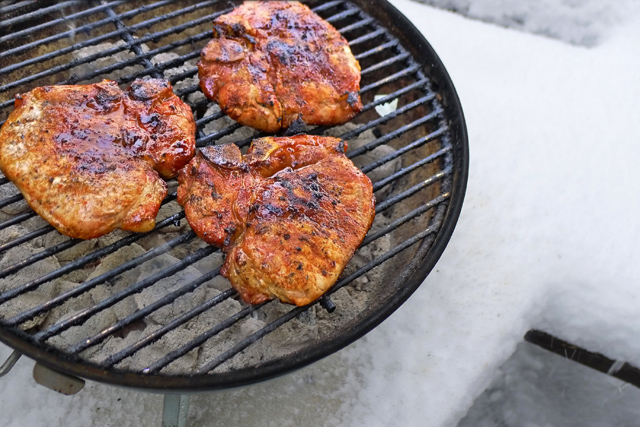
2 ounces (57 grams) of brown sugar
¾ teaspoon of salt
1 heaped teaspoon of mild paprika
½ teaspoon (25 grinds) of freshly ground black pepper
¾ teaspoon of oregano
1 teaspoon of either Ancho or American Chili powder
3 or 4 bone-in loin pork chops, about 1 1/3 pounds total
- Mix brown sugar, salt, paprika, black pepper, oregano and chili powder together in a small bowl.
- Pat dry pork chops and coat both sides with the brown sugar rub. Let sit, covered for 3 hours.
- Light 25 charcoal briquettes in a small barbecue for 20 minutes or so and heat until red hot. Add another 10 briquettes, put on the grill and let heat for 10 more minutes.
- Grill the pork chops quickly over high heat, turning every 2 minutes to prevent burning. Add the exuded liquid as you turn the chops.
- Chops will be ready in 6 to 8 minutes, depending on heat and the thickness of your chops.
Now put another log on the fire – a big one that will last for a time. Sit by the fire, drawing your plate and a good book into easy reach. And watch the snow falling outside, settling on the trees, the deck and the landscape. A glass of wine? Sounds good to me! Life is good here.
Copyright © 2012 by Don Hogeland

You never forget your first sformato. We were in that little trattoria on the north shore of Green Lake, absorbed by an inner glow that transcended the gusts of rain throwing themselves against our window. Inside the restaurant with its fabulous smells, all was candlelit and cozy.
Our waiter’s humor and his rounded Balkan accent were totally infectious: extra garlic for the head cold, sir? I think we have a quantity of that somewhere. Behind a long low wall, a grizzled man moved about the kitchen with quiet authority. By the time our appetizer arrived, we were practically purring.
A sformato is a thing of beauty. Somewhere between soufflé and cake, it’s loaded with intense flavor. My go-to Italian cookbook, The Silver Spoon, lists numerous entries for vegetable infusions – carrot, zucchini, onion, spinach – as well as fishier options.
Back at our table the waiter hovered. Our first forkful was to die for. Light, assertive, delicious. Even the grizzled man looked up from his pots to smile. We raised our glasses and toasted what we both knew was around the corner: sun-drenched pizza parties, our antipasto platter graced with this new addition. We sat back satisfied. Bellissimo! It’s all good here.
Broccoli Sformato
Makes 4 small molds, properly called ‘Sformatini’
4 8-ounce ramekins or ceramic molds
2 teaspoons each butter and breadcrumbs
A rectangular casserole large enough to hold the ramekins
10 ounces of broccoli florets
½ cup of vegetable broth
2 ounces of finely chopped onion
2 teaspoons of olive oil
2 ounces of ricotta cheese
1½ Tablespoons of butter
2 Tablespoons of flour
¾ cup of 2% milk
2 eggs
2-3 cups of boiling water
Prepare molds for filling: Spread ½ teaspoon butter on sides and bottoms of 4 ramekins. Dust with seasoned breadcrumbs. Put ramekins into a rectangular casserole large enough to hold them in one layer and set aside. Preheat oven to 375°.
Pre-cook vegetables and purée: Put broccoli florets and ½ cup veggie broth over medium heat in a 2-quart saucepan. Turn once when boiling; cover and simmer for 4 minutes and then remove broccoli to a bowl to cool slightly. Meanwhile, sauté the onion in oil until it’s translucent; do not brown.
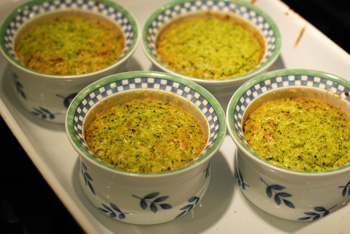 Cooked Sformatini in their ramekins and water bath Shave ¼ cup of green broccoli buds from the florets and set aside for later. Put the rest of the broccoli, broth, onion and 2 ounces of ricotta cheese into a food processor and pulse for 10 seconds until chopped.
Make a thick béchamel sauce: Clean out the 2-quart saucepan and melt 1½ Tablespoons of butter in it over medium heat. Add 2 Tablespoons of flour and incorporate. Add the milk in 3 portions, mixing well and allowing to bubble before next addition.
Finish the filling: Whisk 2 eggs in a bowl. Add hot béchamel to the eggs in 3 portions, whisking quickly, until you have a smooth sauce. Add this to the food processor with the broccoli mixture. Pulse to blend, scraping the sides as necessary. Lastly, add the reserved broccoli buds. Mix them in but don’t purée: these will give a nice texture to your sformato.
Taste the filling and add salt and pepper if desired.
Fill and bake: Pour the broccoli sauce evenly into ramekins, to about ¾ full. Add boiling water to the casserole around the ramekins to bring water 1” up the sides. Bake at 375° for 35 minutes, until lightly browned and springy.
To serve: Let cool for 20 minutes, turn out and serve. Or, you can hold the sformatini in their ramekins for up to 3 days wrapped in plastic and refrigerated. To reheat, turn them out onto a cookie sheet, sprinkle with breadcrumbs and bake for 12 minutes at 350°.
 Green Lake, Seattle's favorite park. Trattoria Cioppino is a lovely half mile walk, left along the walking path and across the street.
For at least as long as the Salad Queen and I have been married, we’ve been working to create the perfect bread to grace our family table. Over the years, those loaves have morphed from long-fermented ones that always seem to flatten out on the bottom to high-rising smoky loaves from the woodfired oven that you want to grab to your nostrils and inhale deeply. Along the way, I’ve tried out different shapes, different ovens, different techniques and different ingredients. As with many things in life, it turns out that when it comes to good bread, simple is often the best.
What may surprise you (but won’t surprise a professional baker) is that the most important ingredient in making great bread is patience. After you’ve assemble the most honest of ingredients and kneaded adequately to bring them together, the best approach is to wait. The hydration process needs to happen; it can’t be rushed. And the yeast needs time to do its job.
So here’s the latest homespun bread we’re making at Chez Bullhog. The loaves aren’t always perfect, especially when dealing with a winter oven, but the flavor and the texture are wonderful. As my next door neighbor asked me the other day when I presented her a loaf, “Can it get any better?” She held the fresh bread to her nose and squeezed the crackling crust to release its heady aroma.
Just wait, I told her. I’ll come up with something.
Crusty Artisan Loaves from Chez Bullhog
Makes 3 loaves, about 25 ounces apiece
¾ cup (4 oz.) of rye flour
1¼ cups (6.5 oz.) of spelt flour
2 Tablespoons of flax seed meal
3 teaspoons of salt
2 teaspoons of dry yeast
1 liter (4¼ cups) water at 100°
5 cups (26 oz.) of all-purpose flour (see note)
2 cups additional flour for bench work
Flour Note: For best results, use good all-purpose flour with 4 grams of protein per ¼ cup. Bob’s Red Mill, King Arthur’s and Trader Joe’s flours all work well for this bread. Avoid higher-gluten flours; at 5 grams of protein per ¼ cup, they will create stiff bread with great structure but will also have a tendency to form a brittle crumb.
Make a soft dough: In a large bread bowl, mix together rye, spelt, flax seed salt and yeast with the handle of a wooden spoon. Add water and mix to make a smooth porridge. Add 5 cups of all-purpose flour to the bowl. Vigorously incorporate the flour, scraping the sides of the bowl as necessary, until you’ve created a smooth dough. Let the dough sit for 15 minutes in the bowl before proceeding.
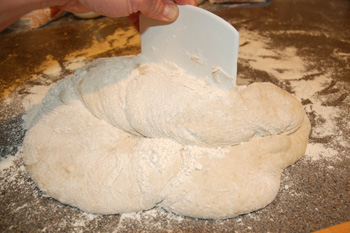 Using a dough scraper in the kneading process Knead the dough: Sprinkle 2 cups of flour onto a work surface. Scrape the dough from the bowl onto the middle of this and, using a dough scraper or plastic container lid cut in half, pull the edges of the dough up to fold into the center as you would an envelope. Knead lightly for 7 to10 minutes, using only as much additional flour as necessary to keep from bogging down your fingers. The goal here is a soft smooth dough with a springy texture.
First rise: Clean the bowl and put the dough back into it (no oil or butter needed). Cover lightly and let rise for 2 hours in a warm (75-80°) place.
Advanced option: In this first rise, you can improve the texture of your finished loaves by a) lowering the temperature to 60° or b) decreasing the yeast by half. The time taken for the dough to rise will be 4 or 5 hours in either case. For a true artisan technique, do both and then allow the bread to proof overnight. Punch down the dough and let it sit at 75-80° for an hour before continuing.
Second rise: Once the dough has become puffy and fills the bowl, use the dough scraper to bring the edges into the center to release the air, inverting the dough if possible. Cover and let rise another 1½ – 2 hours.
Form the loaves: Turn the dough out onto a floured work surface and divide the dough into 3 equal parts. Tuck the edges under lightly to make mounded balls, and place onto floured cloth napkins in bread baskets. Let rise 45 minutes to an hour.
Preheat the oven: Set quarry tiles or a pizza stone onto the middle rack of your indoor oven and preheat to 450°. Or – if you’re lucky enough to have a woodfired oven – get your outdoor oven moderately hot over a 2-hour period.;.
For baking in a conventional oven: Turn the risen loaves out of their baskets and onto floured peels. Slash or decorate your loaves if desired. Slip them directly onto the quarry tiles or pizza stone. Lower the heat to 425° and lower it again to 375° after the first 15 minutes to replicate the falling heat of a woodfired oven. Bake for 50 minutes to an hour, until loaves are medium brown and crusty.
For baking in a woodfired oven: Your oven should be well heated but not scorching. (If the ash on the walls of your oven has turned white, it’s too hot; wait 30 minutes) Sweep the floor clean of ashes and push the coals to the back. Slip the loaves into the oven about 12” from the coals in a semi-circle. Turn the loaves around after 20 minutes; ¼ turn after another 20 minutes; and all the way around again after another 10 minutes. Loaves will be done after 1 hour altogether.
Cool the loaves on a rack for 30 minutes before digging in.
Now gather ‘round the table and enjoy the oohs and aahs as your friends and family remark on your ability to create a fantastic bread. But be forewarned: even basking in the glow of their kudos, you’ll be assessing your next creation. I know; I’ve been there for a long long time!
Copyright ©2012 by Don Hogeland
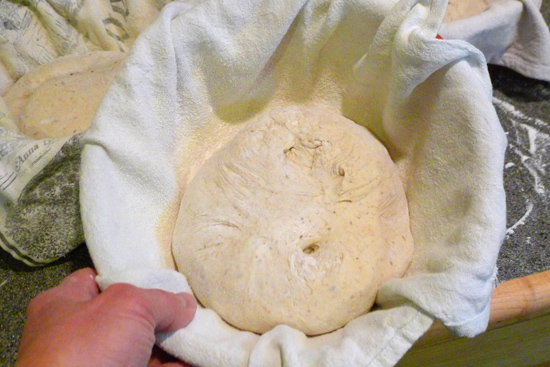 Loaves proofing in the basket: upright or upside down, it works either way!
When it comes to lasagna, size matters. Just as with great ski terrain, steep and deep is good. You want your teeth to bite into a mouthful of flavor, cascade off the noodles and sink your taste buds into pockets of cheese that go forever. Ah, now that’s the good stuff.
So when Jonathan from Norway the other day asked me, “What size is your lasagna pan?” his question threw me. In my family – forever, it seems – the standard glass Pyrex pan has been the pan of choice. It’s cheap and available everywhere. The 4.8 quart 10” x 15” version makes enough lasagna for a hungry crowd, while the smaller 3 quart version does for less people. But in my book these pans have a drawback: the lasagna is too darned thin.
Enter the loaf pan. These glass pans, measuring 4.5” x 8.5” with nearly 3 inches in depth, make excellent deep dish lasagna. They accommodate 8 layers of noodles, allowing for a mountain of flavor that fits easily into your oven. They also make it easy to please the vegetarians in your life; at Chez Bullhog, we almost always make a meat and a veggie version. But be warned: all this steep and deep stuff just might create an avalanche of flavor on your plate!
Steep and Deep Loaf Pan Lasagna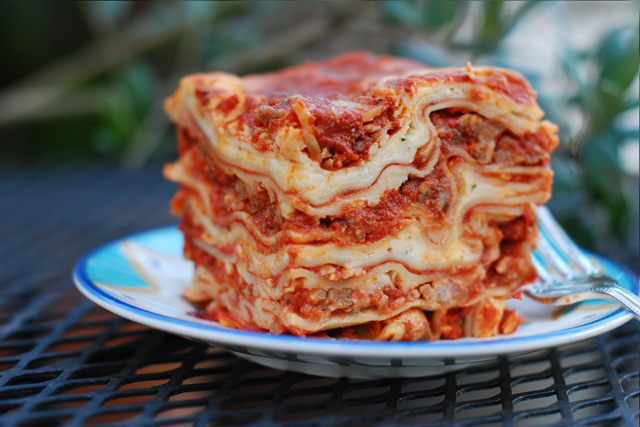
Makes 2 lasagne – one meat and one veggie – enough for 8 servings
6 cups of tomato sauce, preferably homemade
One package (8 ounces or 16 noodles) of no-boil Barilla lasagna noodles
6 cups of water at 150°
8 – 12 ounces of shredded mozzarella cheese, depending on taste
For the cheese filling:
16 ounces of ricotta cheese
2 ounces of shredded mozzarella
1 egg
1 or 2 cloves of crushed garlic
1 teaspoon of oregano
For the meat filling:
8 ounces of mild Italian bulk pork sausage
1 or 2 cloves of crushed garlic
¾ cups of tomato sauce
For the veggie filling:
1 pound of fresh spinach, rinsed and drained
1 Tablespoon of olive oil
1 or 2 cloves of crushed garlic
½ teaspoon of salt
Make the cheese filling: In a wide soup bowl, mix together the ricotta cheese, 2 ounces of shredded mozzarella, 1 egg and 1 or 2 cloves of crushed garlic, depending on how much garlic you like. Stir in the oregano at the end. Cover and set aside.
Make the meat filling: Meanwhile, brown 8 ounces of bulk Italian sausage in a frying pan over medium heat. Break the meat into small pieces as it cooks and add 1 or 2 cloves of garlic. When the meat starts to stick to the pan, add tomato sauce, stirring to incorporate. Turn heat off and cover the pan.
Make the veggie filling: Heat half the olive oil in a 12” frying pan over medium heat and, when hot, add half of the rinsed and drained spinach. After a minute, turn spinach over and simmer on the other side for a minute or two. As soon as the spinach is wilted (but not cooked to a mush), add some crushed garlic and salt and move to a bowl. Do the other half of the spinach the same way. Before adding, squeeze the spinach leaves and either discard or reserve liquid for another use.
Get the noodles ready: In an 8” x 8” pan, pour 4 cups of 150° water over 8 of the no-boil noodles. Let soak for 10 minutes. Add the last of the hot water and the other 8 noodles in the middle of assembling the lasagna.
Assemble the lasagne: With 2 loaf pans on a counter, it’s best to build both of the lasagne at the same time. Start with a small amount of sauce, just enough to cover the bottoms of the pans. Put down a heated noodle. Now top with either half of the spinach or half of the meat sauce (depending on the lasagna) and spread to the edges. Sprinkle on a bit of cheese and top with a heated noodle. Cover with about ¾ cup of tomato sauce and a little more cheese. Put on another heated noodle and onto each of the lasagne spread ¼ of the cheese filling; top with another heated noodle and ¾ cup of tomato sauce.
Repeat this process with the additional noodles, ending with a generous topping of tomato sauce and a sprinkling of cheese, if desired.
Bake the lasagne: Preheat the oven to 400°. Bake for 15 minutes at 400° on a center rack and then lower the temperature to 350°. Bake for a further 35 to 40 minutes, until the sauce bubbles up around the edges. Put a piece of foil on a lower rack to catch the drips if the pans bubble over. Let cool 15 to 30 minutes before slicing and serving.
This recipe is dedicated to the lost souls of last week’s avalanches at both Stevens and Snoqualmie Passes. Our hearts go out to the victims’ families and the survivors. Every time we carve the big bowls, we’ll be thinking of you.
Copyright ©2012 by Don Hogeland
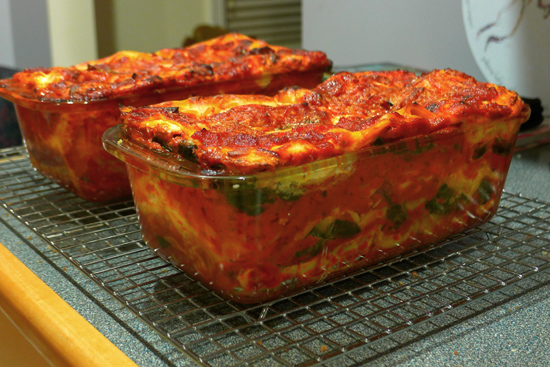 Lasagne in the pans: veggie lasagna with meat lasagna in the background
Here’s a simple way to turn a tasty dinner into a love fest. At Chez Bullhog, we have crab cakes at least once a month, made with fresh Dungeness Crab – a local favorite here in the Northwest. We spice them either with a bit of curry or this way, with Cajun spicing. Turning them heart shaped for a ‘Valentine eve’s dinner’ brought smiles around the table. I mean, hey! What’s not to love?
Heart Shaped Cajun Crab Cakes 
Makes 5 patties
10 ounces of crab meat, picked clean and drained of excess water
3/4 to 1 cup + ¼ cup Italian style breadcrumbs
4 spring onions
1 egg
2 Tablespoons of mayonnaise
¼ teaspoon of salt
1½ teaspoons of Cajun spice
½ teaspoon of American chili powder
1 Tablespoon + 1 teaspoon canola oil
1 Tablespoon butter
A 3” heart-shaped cookie cutter
- Cut the bottom 5 inches from the onions, discarding the tops but keeping some of the green. Trim off roots, slice lengthwise in quarters and chop finely.
- Break any large bits of crab into chunks. In a mixing bowl, lightly combine the crab, onion, 3/4 cup of breadcrumbs, mayonnaise, salt, and Cajun spice. Break the egg over the top and toss to incorporate. The mixture should be somewhat wet but not runny; if you can’t make a ball with the mixture add up to ¼ cup more breadcrumb.
- Sprinkle half of the reserved breadcrumbs onto a pizza pan or large dinner plate. Make 5 balls with the crab mixture and set them onto the breadcrumbs. (You’ll want to clean off your hands at this point.)
- Put the cookie cutter over a ball and dust it lightly with breadcrumbs. Press the crab mixture all the way to the sides of the mold with your fingers, making the patty as even in thickness as you can. Carefully release the heart and clean off the sides of the cookie cutter if necessary. When you’ve done all five, sprinkle the tops with a bit more breadcrumbs and dust with chili powder.
- Heat 1 Tablespoon oil and 1 Tablespoon butter over medium heat in a 12” frying pan. Put the side with the chili powder down against the oil and fry for 4 minutes. Dust the tops with chili powder before turning, add the last teaspoon of oil to the pan and fry on the other side for another 4 or 5 minutes until medium brown and slightly crispy.
- Turn the burner off, put a lid on the pan, and let steam for 5 minutes or until ready to serve.
Toss in a little candlelight, some champagne? Now you’re talking!
Copyright © 2012 by Don Hogeland
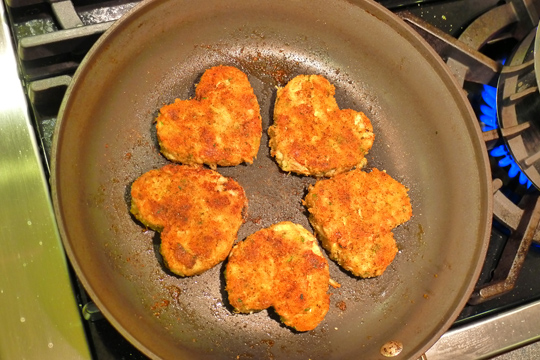
The tongue of heat that laps at the Maremma’s hardened landscape takes away our breath. We’re only three hundred feet down the trail that leads to the sea and already gasping for water. Not only is the heat scalding our lungs, but the signs warning of malaria mosquito are freaking us out. A long-horned bull surveys us with doleful brown eyes. Sunscreen. Check. Bugspray. Check. I grab up the pack, look nervously at the tethered bull and hurry to catch up with my family.
We wanted wild. We just didn’t exactly figure on this kind of wild. Who would have thought that Southern Tuscany could be outright dangerous?
 The Bullhogs seeking shelter in the only shade available To be sure, our accommodations that week were idyllic: we were staying in the corner of an old monastery converted into apartments. Our view took in olive groves and vineyards. Nearby a forest of cork oaks glistened in the evening sun. The day we arrived, a glass of champagne set the tone for an amazing dinner; everything except the cheese was made right there on the premises. By the time old man Locatelli explained with a glint in his Italian eye that he’d even hunted the boar that graced the main dish, I figured I’d died and gone to heaven.
But as an inferno set in the next day and the hum of insects in the towering chestnut outside our door revved loud as a lawnmower, I was having second thoughts. Giant wasps with segments the size of wine corks plied the air, investigating leafy crevices and sometimes the eaves of our apartment. And while the penned tortoises and porcupine quills that golden-haired Locatelli the younger showed our kids intrigued them, at the same time they were sufficiently overwhelmed to sleep badly at night.
Meanwhile, out on the beach in the Parco Nazionale di Maremma, we dipped our toes in the Tyrrhenian Sea and raced back to the car park. Finally, out of the intense heat we turned the car’s air conditioner to high, skirted Grosseto along a ribbon of asphalt and headed toward civilization. At Castiglione della Pescaia, we perched at a table in the square as the sun dipped. And while the Salad Queen escaped to seek out the perfect bottle of limoncello, I fed the kids on gelato and sampled the local specialty: seafood risotto.
Oh, so civilized. Here’s my take on it.
Simple Seaside Risotto with Scallops
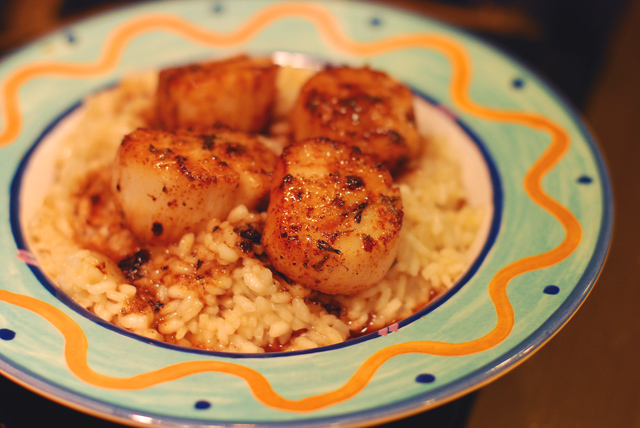
Makes 2 generous portions
6 ounces of yellow onion, chopped finely
2 cloves of garlic, minced
2 Tablespoons of good olive oil
1 cup good quality Arborio rice, preferably carnaroli or vialone
3 or 4 ounce of dry white wine (optional)
3 cups of hot stock (fish, chicken or vegetable)
12 ounces of scallops, patted dry
Paprika, salt and pepper to taste
1 Tablespoon of butter
2 ounces freshly grated Parmesano Reggiano or Grana Padano to finish
A note on ingredients: In such a simple dish, the quality of the ingredients is ultimately important. Buy some decent rice (I use carnaroli or vialone even though it’s expensive). Use good olive oil. Make your own stock if you can. Because my vegetarian wife was out of town when I made this recently, I added a full-flavored chicken stock I’d simmered for two days and it made a big difference. As to the scallops, I’ve made this with both sea scallops and bay scallops, and both have their fine points; go with what you like.
To make the risotto:
- In a 3-quart stainless steel sauté pan or large frying pan, cook 6 ounce of chopped onions in olive oil over medium heat for 3 or 4 minutes until they begin to turn translucent. Add the garlic and, stirring, cook for a minute longer. If the onions begin to brown at the edges, take the pan off the heat and let it cool for a minute before continuing.
- Meanwhile, get your stock hot in a saucepan on a nearby burner. For best results, the stock should be at a low simmer when added to prevent thermal shock to the rice. Have a 4 ounce ladel ready for making additions.
- With the sauté pan over medium heat, add 1 cup of Arborio rice to the onion mix and, stirring constantly, coat the rice with the onion and oil. Cook for 1 minute. Add a couple of ounces of white wine at this point to flavor the rice, if desired.
- Set a timer for 17 minutes. (It is more important from this moment that the rice is perfectly cooked than that a fixed amount of liquid is incorporated. All rice is different, and so will absorb different amounts of liquid, but all good arborio rice will be cooked in 17 to 19 minutes).
- Now add ½ cup (4 ounces) of hot broth to the sauté pan. Using a spatula, flip the rice over and at the same time clean any bits that are sticking to the bottom of the pan. After about 2 minutes, add another ½ cups of broth. As the rice absorbs the broth, continue flipping it over every minute or two, stirring only a little as necessary to even the rice out in the pan. Add small quantities of broth, allowing the rice to absorb most of the broth each time. Never let the rice dry out all the way, but don’t let it get overly soupy either. As time runs out on the timer, add smaller amount of broth so that you can arrive at a risotto that is slightly creamy but cooked until soft on the outside with a bite on the inside – what Italians call ‘al dente’. After the 17 minutes, remove from heat and leave uncovered.
To cook the scallops:
- Set the scallops onto a bed of paper towels and pat the tops dry as well. For success with scallops this is very important. Season the dried scallops on both sides with paprika, salt and pepper.
- With five minute left on the timer for the risotto above, heat butter in a 10 inch frying pan over medium-high heat. Add the scallops and cook for 2 minutes on one side. If a lot of liquid is exuded by the scallops, remove them to a plate and clean the pan; otherwise, turn the scallops to cook for 2 minutes on the other side.
- Remove the scallops to a side plate and deglaze the pan with a Tablespoon or two of water.
To finish the plate: Add the parmesan cheese to the rice and mix well with a wooden spoon. Scoop half of the risotto onto each of two plates (or into bowls) and put half of the scallops over the rice. Pour the pan drippings over the scallops and rice and bring steaming to the table.
Now imagine the Mediterranean sparkling blue-green in the distance. Life is good here…. Enjoy!
 Street scene in the square at Castiglione della Pescaia
“Daaad. What’s for dinner?” My teenaged daughter’s voice came muffled but urgent from the next room. I pushed her door open to see familiar white earbud wires streaming from her newly cropped head. Homework papers sprawled across the covers that she had pulled up to her chin. Her phone and laptop were within easy reach.
“Chicken pot pie,” I said as casually as I could, expecting some new outburst of complaint. But something she’d seen on Facebook had already caught my daughter’s attention. Against a flurry of keyboard taps I closed the door and turned back to my own latest obsession.
At the dinner table, there was an audible silence I did my best to ignore. My son slipped into his chair, adjusted the glasses on his nose, and moved the green beans to get a better look. My daughter carefully lifted the crust with her fork, and looked quietly at her brother. I felt their eyes linger on me as, with serious concentration, I took my first luscious bite. Something in the air relaxed; my new creation had passed the test. Before I knew it the pot pie on my kids’ plates had disappeared without a trace.
My teenaged daughter’s friend was cruising the fridge the next day looking for a snack. “There’s pot pie,” my daughter said casually – as if she’d been eating it all her life. “It’s really good. Here, I’ll heat some up.” She cut off a hunk and refused to catch my eye as she bent to her task. I went back to reading David Sedaris digressing about the weirdness of his life. Okay, I thought: I could hold my silence. I didn’t even crack a smile. But I was laughing inside.
Family Friendly Chicken Pot Pie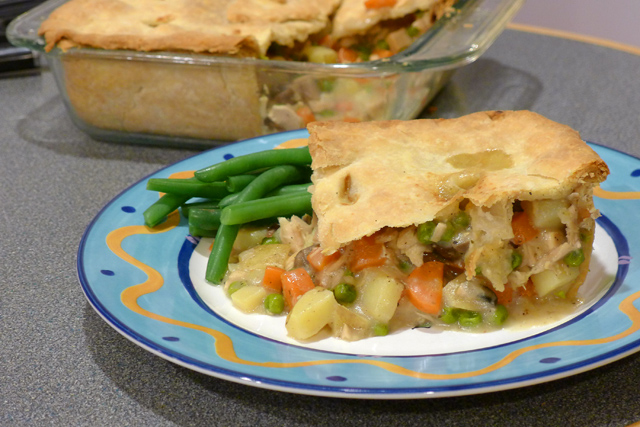
Makes 6 servings
For the Pastry:
2¼ cups of all-purpose flour
½ teaspoon salt
6 Tablespoons of butter
6 Tablespoons of Spectrum Organic Shortening
6 or 7 Tablespoons of very cold water
For the Filling:
1¼ cup of carrots, ½ inch dice
1¼ cup of potatoes, ½ inch dice
½ cup chopped onion
3 Tablespoons of butter
4 Tablespoons of flour
½ cup of milk
2½ cups of chicken broth, preferably homemade
1¼ cup of mushroom, coarsely chopped
2 cups of cooked chicken, ½ inch dice
1 cup of frozen peas
Salt and freshly ground black pepper to taste
Make the pastry: Preheat oven to 375°. In a large bowl, mix together flour and salt. Cut in cold butter and shortening with two dinner knives or a pastry cutter until the bits of fat are the size of peas. Quickly go through with your fingers to crumble them into the flour as best you can. Now add just enough cold water to make the dough into a ball that barely sticks together.
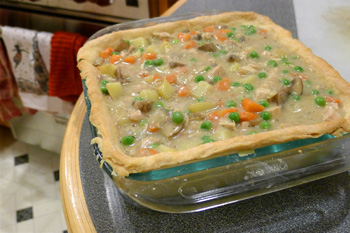 Filled shell ready to top and bake On a floured surface, roll 2/3 of the pastry dough into a 13” x 13” square. Use this to line an 8” x 8” pyrex baking pan, bringing the edges of the dough up over the lip of the pan to prevent slippage. Poke the dough all over with a fork and bake the shell for 12 – 15 minutes on a center rack until lightly browned.
Make the filling: Put the diced carrots and potatoes into a 1-quart sauce pan, cover with water and bring to a boil over medium heat. Cook for 10 minutes until barely tender. Drain water and set the veggies aside.
In a large sauté pan, fry ½ cup of chopped onion in 3 Tablespoons of butter for 4 or 5 minutes until golden. Stir in 4 Tablespoons of flour until if forms a mass. Add ¼ cup milk, heat and stir; add the other ¼ cup milk, heat and stir until there are no lumps. Now add chicken stock in ½ cup portions, allowing each portion to heat thoroughly before stirring it into the flour mixture. Mix well to ensure there are no lumps and let the sauce bubble before adding the next portion of stock. After 5 minutes or so, once all 2½ cups of stock have been added, you should end up with a smooth gravy flecked with onion.
Add chopped mushroom to the gravy, lower the heat and clap on the lid. Let simmer for a few minutes until the mushroom is mostly cooked. Stir in the carrots and potato, simmer a few minutes more, and then turn off the burner.
Assemble the pot pie: Roll the last 1/3 of pastry dough into a 9” x 9” square. Fold diced chicken and frozen peas into the gravy mixture; season with salt and pepper to taste. Scoop or pour the filling into the baked pie shell. Wet the rim of the shell with a bit of water or milk and then put the square of pastry dough over the pie, trimming and sealing the edges as needed. Cut 8 small slits in the top and add a design if desired.
Bake the pot pie: Bake on the center rack at 375° for 35 to 40 minutes, until the sauce bubbles through the slits and the crust is golden brown. Let cool for 15 minutes before serving.
 Add your own whimsical design; your family will love it!
|
A sample text widget
Etiam pulvinar consectetur dolor sed malesuada. Ut convallis
euismod dolor nec pretium. Nunc ut tristique massa.
Nam sodales mi vitae dolor ullamcorper et vulputate enim accumsan.
Morbi orci magna, tincidunt vitae molestie nec, molestie at mi. Nulla nulla lorem,
suscipit in posuere in, interdum non magna.
|
|



























